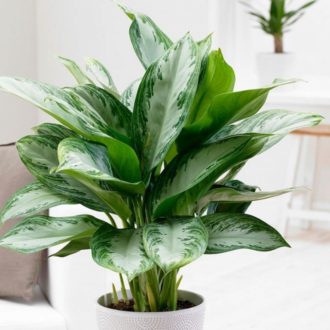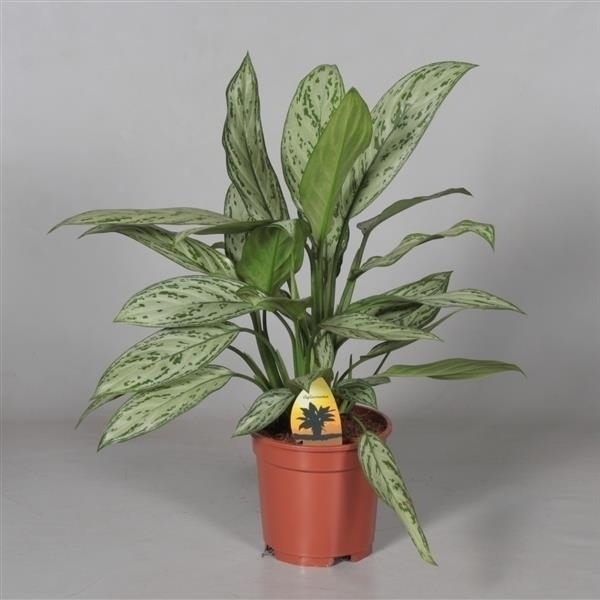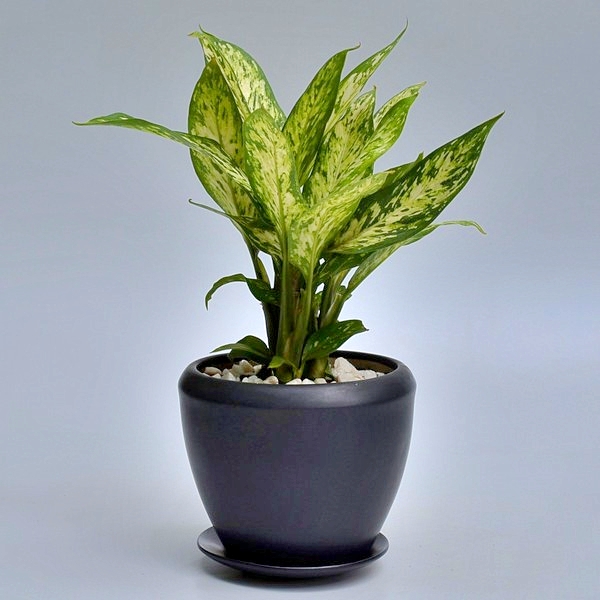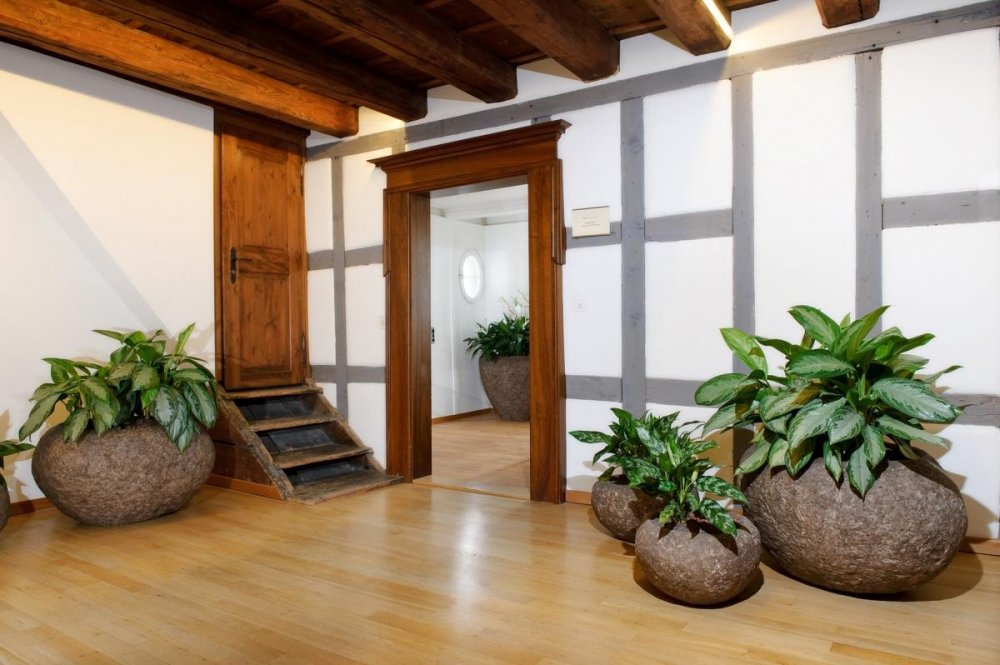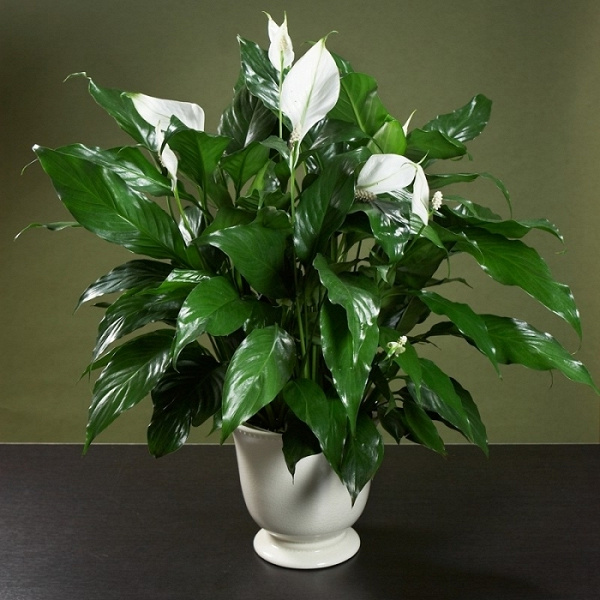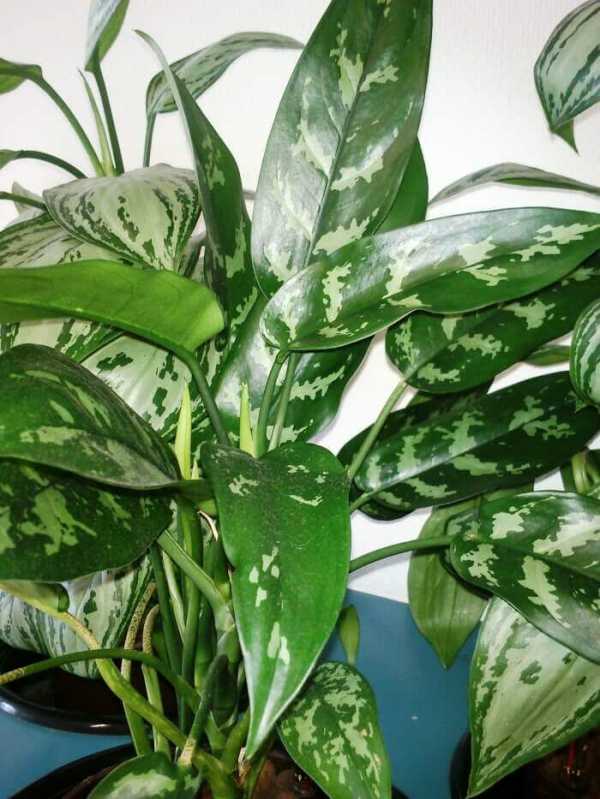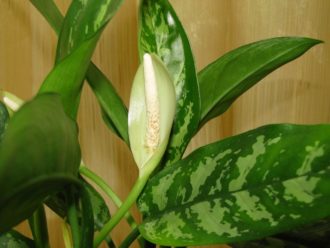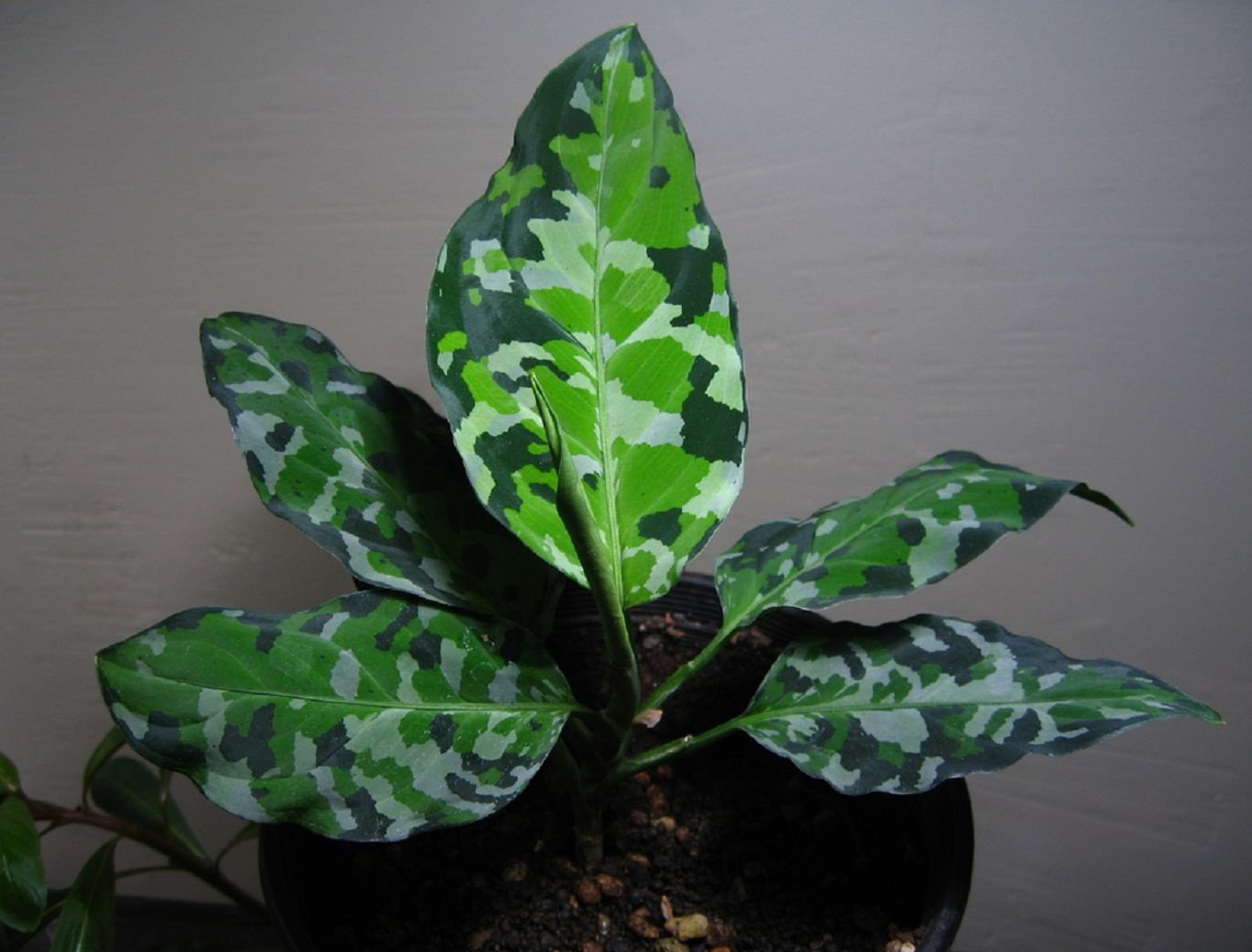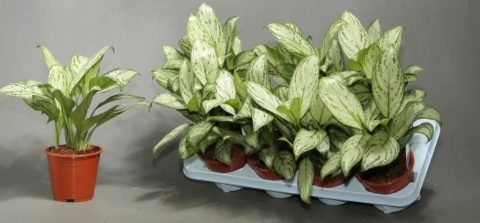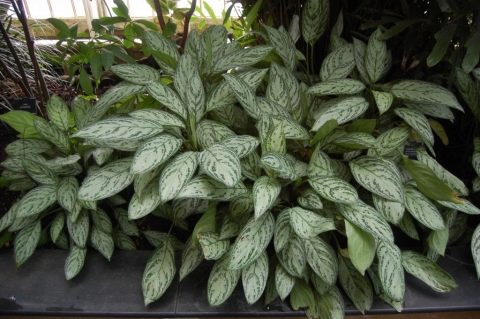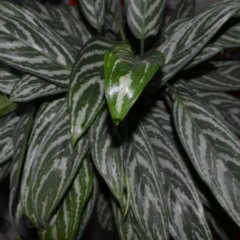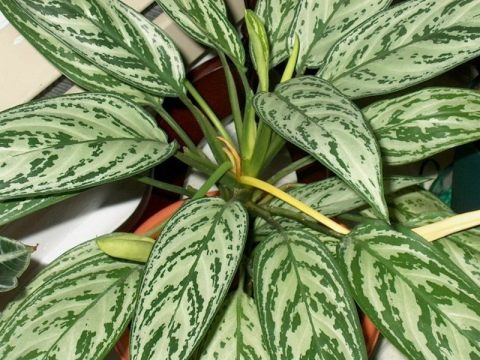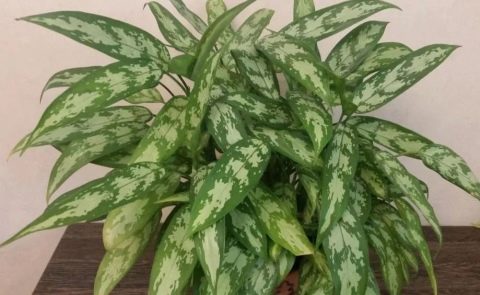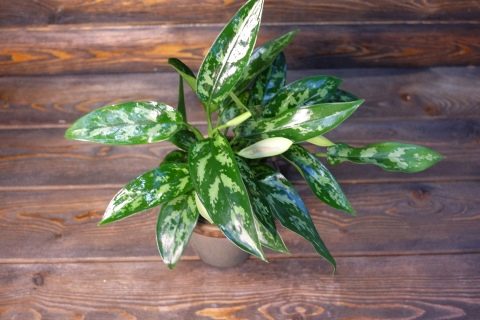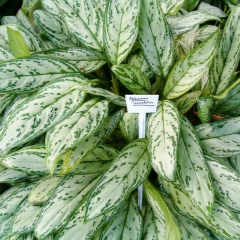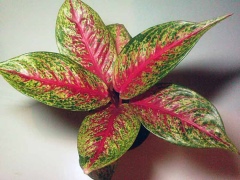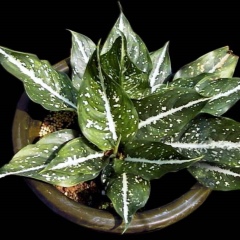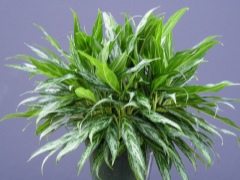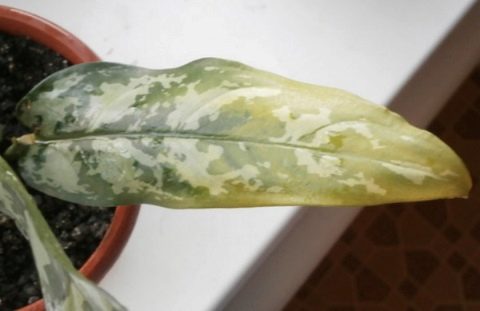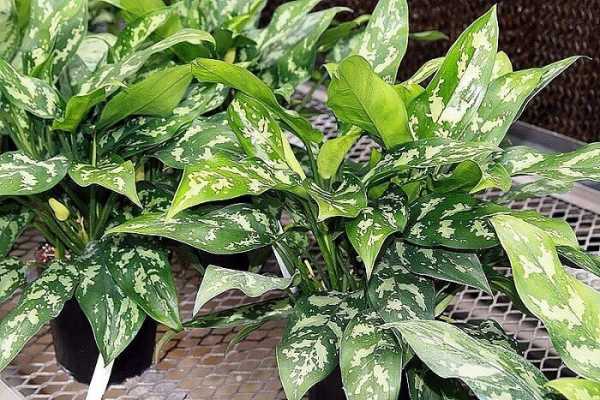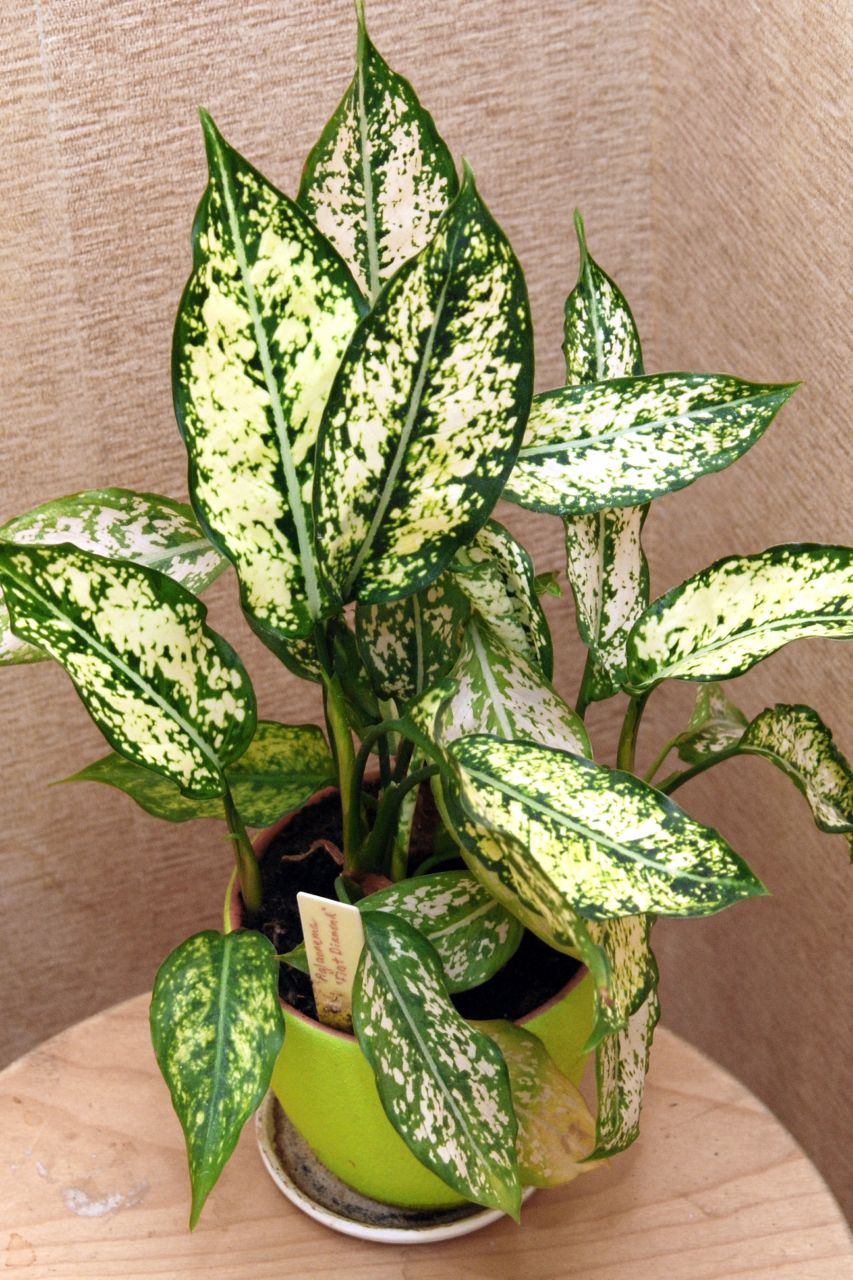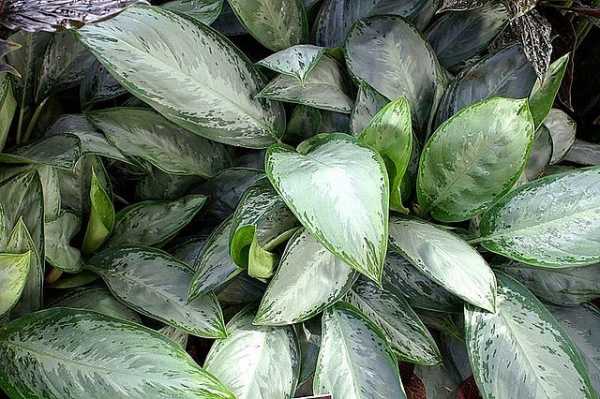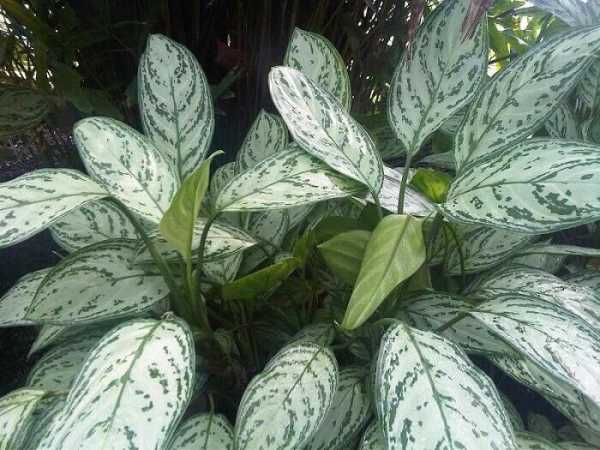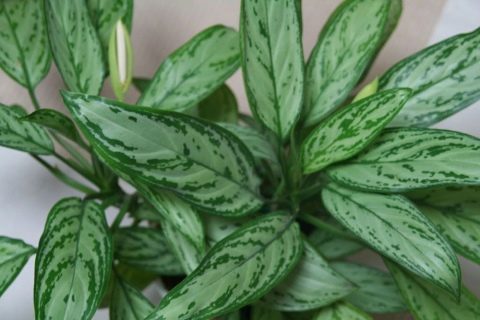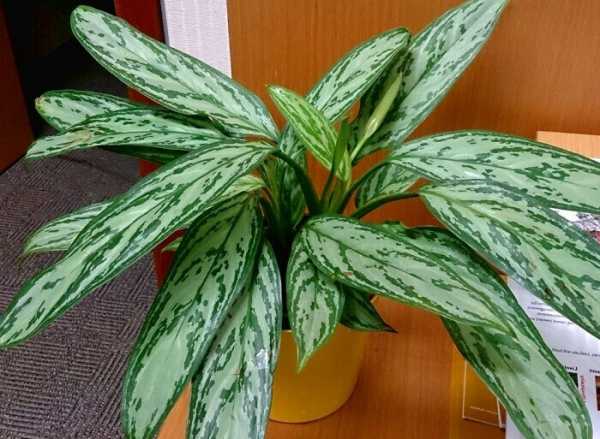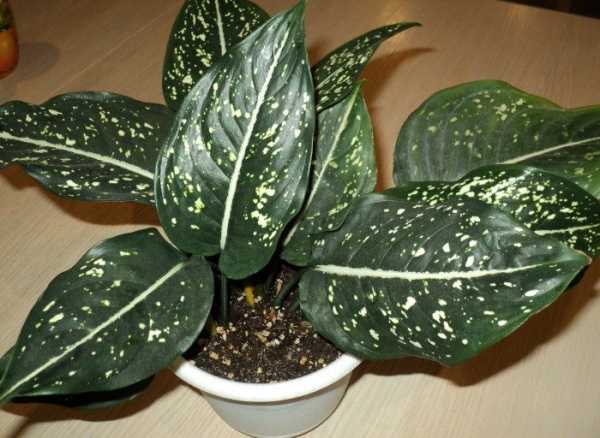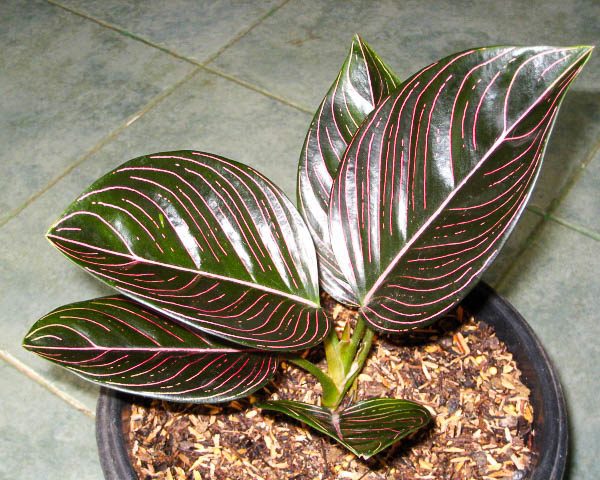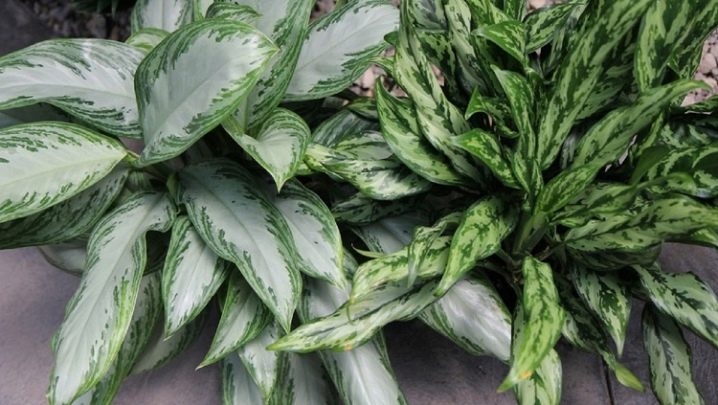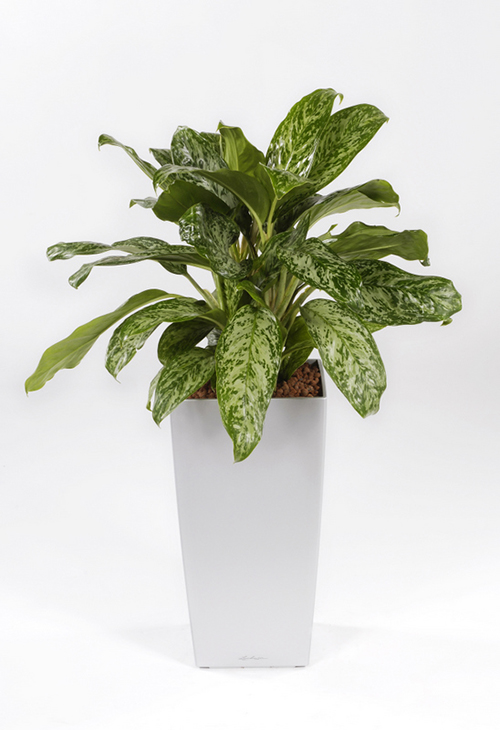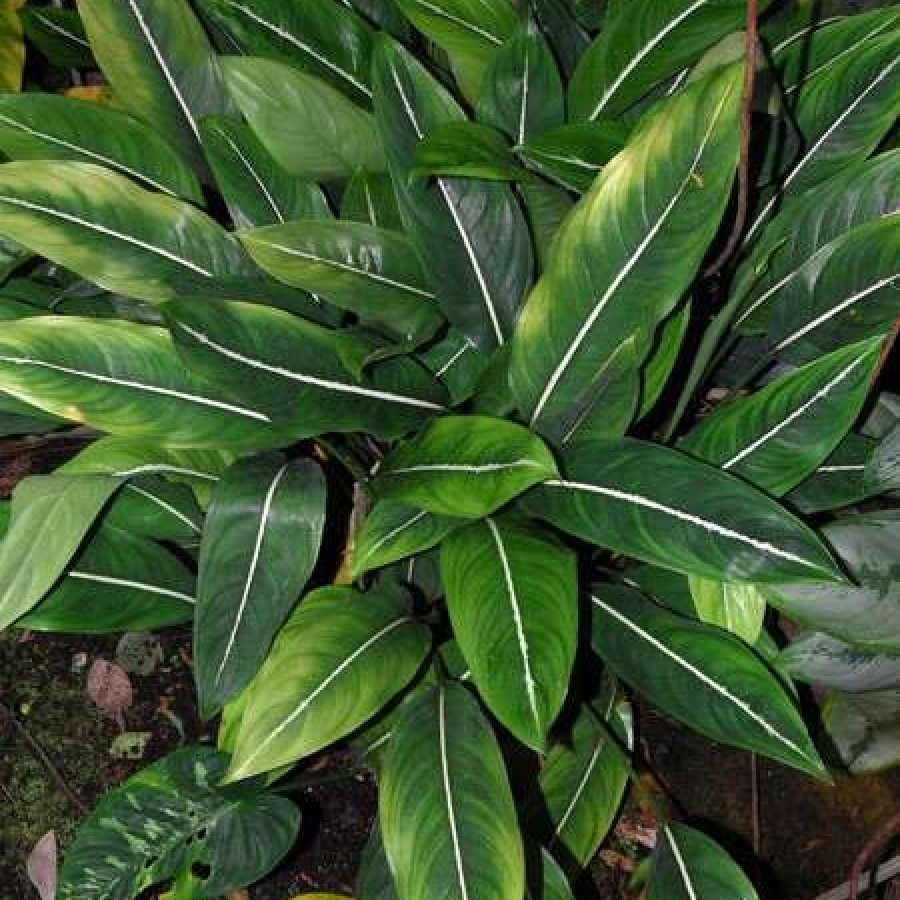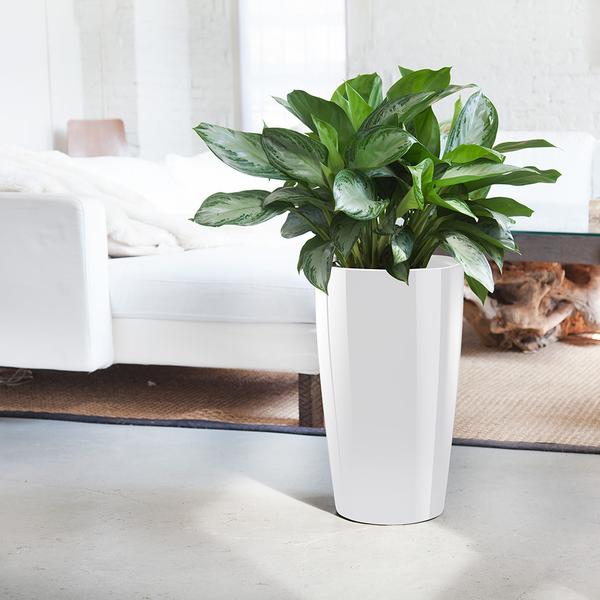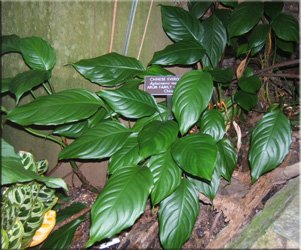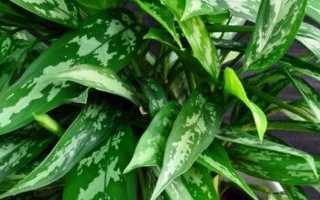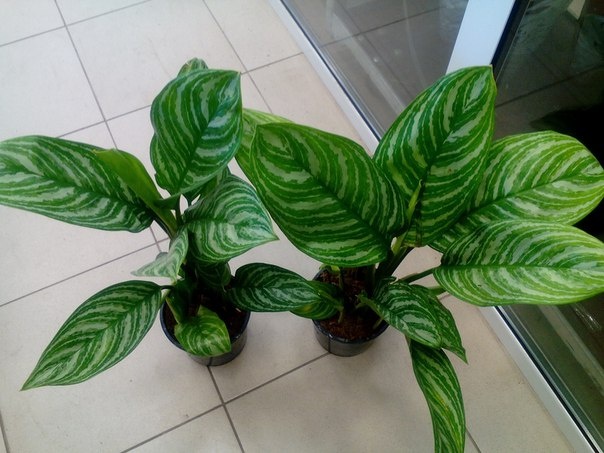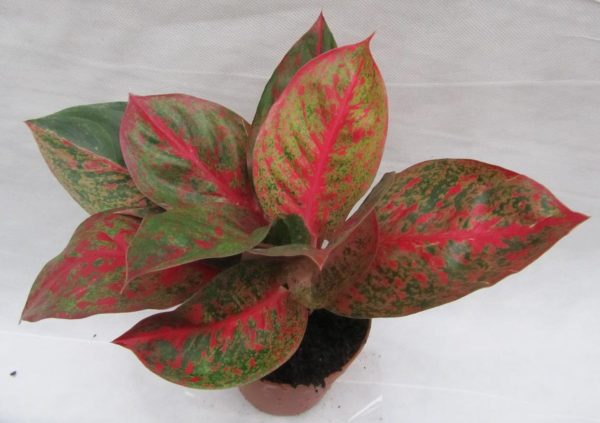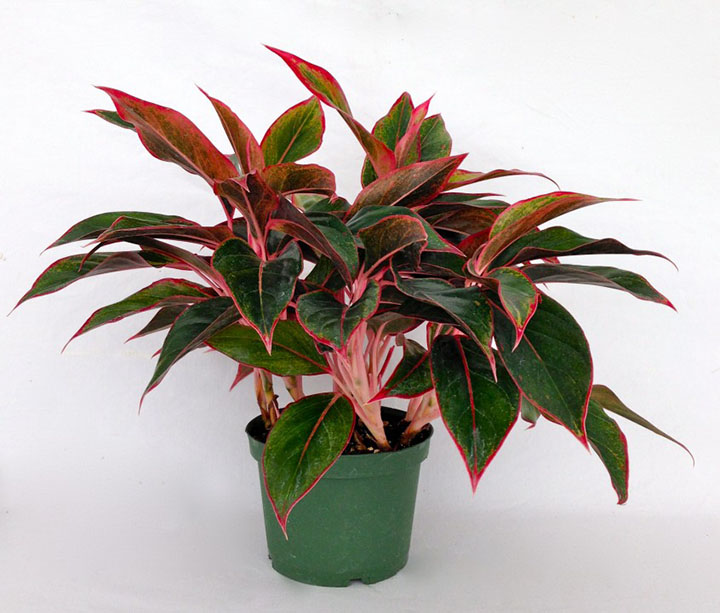Caring for LA and LO hybrids at home
Once you plant a hybrid lily bulb on your site, you will get a wonderful perennial miracle that will delight you for more than one year, provided it is properly cared for.
Lighting
LA and LO hybrids are light-loving plants, prefer well-lit areas, so they should be planted in sunny places, but light shading will not harm them to prevent sunburn on the foliage.
Temperature and humidity
In places planting lily hybrid varieties moisture should not stagnate, as this leads to rotting of the bulb, damage to fungal diseases. Therefore, it is recommended to plant lilies in raised flower beds, having previously introduced drainage into them.
In the case of growing lilies in a greenhouse, you need to monitor so that the air humidity is always 65-85%.
If these conditions are not met, plants can shed their buds, stop growing. To maintain constant humidity, you can set a constant mode of the ventilation system and provide the necessary air circulation. During the formation of the root system of newly planted plants, the temperature should be maintained within the range of 10-18 ° C. After rooting - up to 25 degrees Celsius.
Watering, feeding, preparing for winter
Watering lilies should be done regularly, but consider weather conditions, plant height, and dryness of the soil. In cloudy weather, watering is reduced, and in sunny weather, the need for moisture increases.
It is recommended to feed lilies 3-4 times during spring, summer and autumn with these types of fertilizers:
- After the emergence of seedlings - complex mineral.
- When buds appear - phosphorus-potassium.
- At the beginning of flowering - potash.
- After flowering - phosphorus-potassium.
All dressings are carried out after watering, after diluting with water. Before preparing for winter, LA and LO hybrids should be fed with phosphorus-potassium fertilizer for better subsequent wintering and planting flower buds.
Diseases and pests
To prevent disease or pest infestation, when buying an LA or LO hybrid, be sure to carefully inspect the bulbs. Before planting, they should be treated with Fundazol or a weak solution of potassium manganese. This will help avoid fusarium, onion rot. When covering the leaves and stems with brown spots, it is necessary to use antifungal drugs: Fitosporin or Bordeaux liquid.
Dangerous pests include the lily beetle, which destroys leaves and flower buds. These pests are visible on plants due to their red coloration. To combat them, as well as against aphids and flies, Karbofos, Aktellik, Fitoverm are used. Flycatcher, Thunder, Grizzly will help when bulbs are damaged by a bear, wireworm.
It will also be interesting: Lilia Longiflorum (Lancon, Dolcetto, Miyabi) - caring for long-flowered plants
The best varieties
Maria
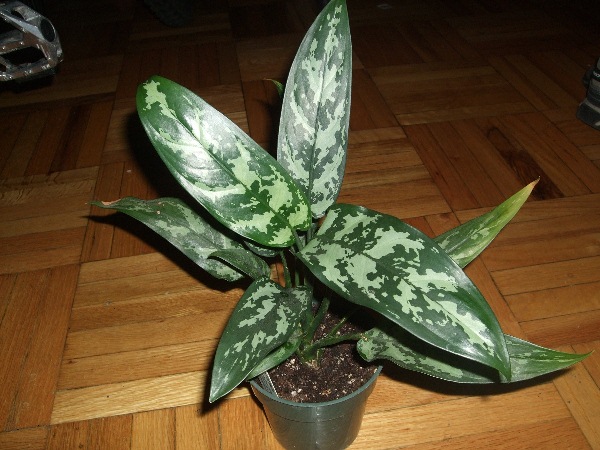 Aglaonema Maria
Aglaonema Maria
This variety has very expressive white spots and occupies 80% of the leaf plate. Due to this, it looks very attractive. The height of an adult plant of this variety is 60 cm, and the leaf plates at the same time grow to a length of 20 cm. The flowering of Aglaonema Maria is a white ear with a white veil of the bride.
Red
 Aglaonema red
Aglaonema red
The species is represented by one variety of Aglaonema - Crete.
Crete
 Aglaonema Crete
Aglaonema Crete
The variety has a height of up to 70 cm. The stems grow straight and have beautiful leaf plates with an unreal color: several shades of green with a beautiful and clear red border. In this case, the length of the leaf is 15 cm.The flowering of the cob is practically invisible, since it is covered, like a hood, with a white blanket.
Treiba
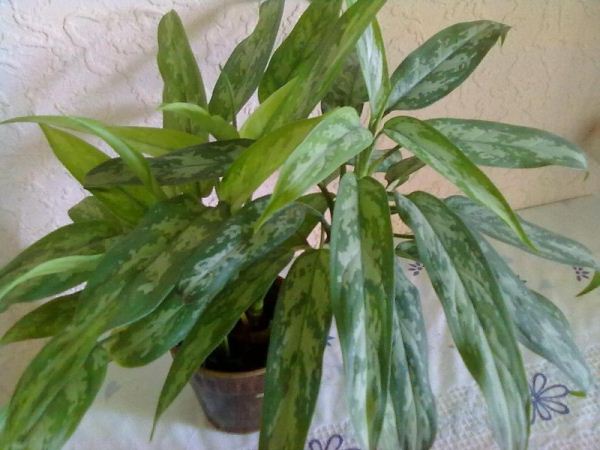 Aglaonema Treiba
Aglaonema Treiba
Aglaonem is not very demanding to leave. The length of the leaf plates reaches 16 cm and alternates between green and light green stripes. At the same time, the pattern is contrasting, blooms with a white cob with a white veil.
Ribbed
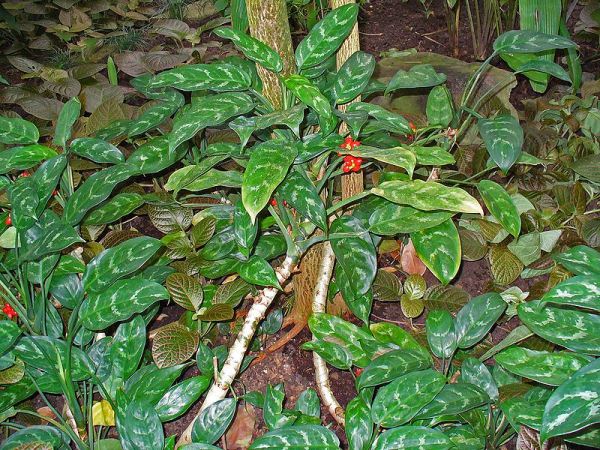 Aglaonema Ribbed
Aglaonema Ribbed
Malaysia is considered the birthplace of the species. This is practically the smallest species, specimens of which grow no more than 20 cm. The leaf plates have an emerald color, along which the strokes of a white shade are located. This species has, and its second version, where the foliage remains green and only the vein located in the center of the leaf is white. It blooms on a white cob with a white-green veil.
Short-coverage
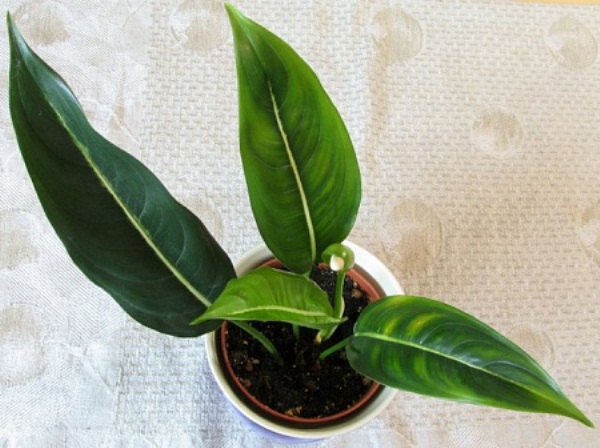 Aglaonema Short-Covering
Aglaonema Short-Covering
In this plant, the trunk spreads underground, there are practically only leaves above it. These are oval leaf plates, narrow with a sharp end. Their drawing on a dark green background from the center there are stripes of light emerald color.
The plant grows very slowly. Flowering is a white ear with a white veil.
Rounded
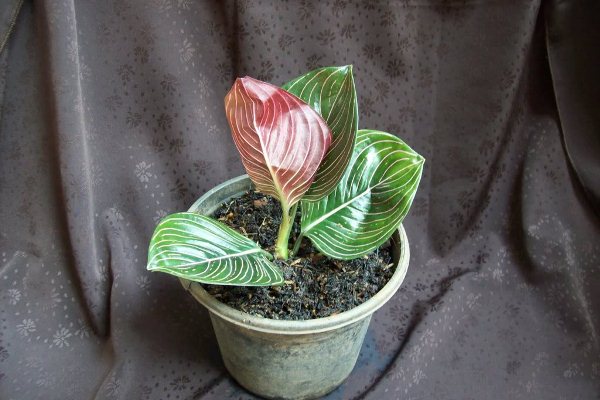 Aglaonema Okruglaya
Aglaonema Okruglaya
Stunted appearance with dark foliage shaped like a pointed heart. On dark leaf plates, pink veins stand out beautifully, the color of the veins can vary depending on the variety. Depending on the variety, the ear cover can be white or slightly pinkish.
Silver Queen
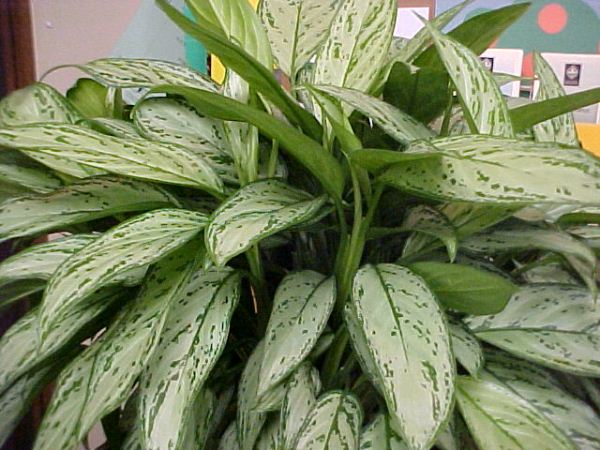 Aglaonema Silver Queen
Aglaonema Silver Queen
The compact plant, growing to a height of about 30 cm, has dark green leaf plates on which there are lighter spots. The length of the leaf is 15 cm. It blooms with a white ear, covered with a white blanket on one side.
Modest
 Aglaonema the Modest
Aglaonema the Modest
Weed considers the tropical zone of China and Bangladesh as its homeland. A highly branched small shrub with a mass of bright green foliage. Absolutely not a whimsical variety that requires almost nothing but watering. It tolerates full shade well, which cannot be said about other plant varieties. The height of the plant is only 50 cm. The length of the leaf plate is 20 cm. The flowers are collected in a white ear and covered with a white-green veil.
Silver Bay
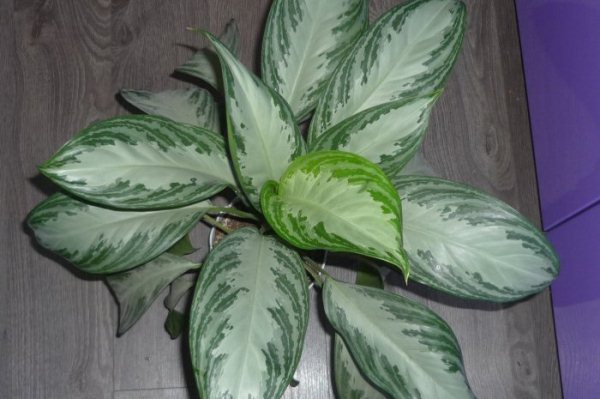 Aglaonema Silver Bay
Aglaonema Silver Bay
A respectable tall specimen. The height of an adult plant is 100 cm, this variety is frost-resistant, but this does not allow it to grow on our street in winter, it just tolerates cold well. The leaf plates are up to 30 cm long. In the center of such a green plate, there is a light spot surrounded by lighter spots.
As the leaf ages, it becomes darker green. Flowering occurs on a white cob with a white veil.
Stripes
 Aglaonema Stripes
Aglaonema Stripes
This Aglaonema is also called "striped". Oval-shaped leaf plates with a sharp end. The length of the sheet is 35 cm, while the width is 14 cm, there are three shades on the sheet:
- Silver shade.
- Dark green color.
- Light green color.
Due to the fact that the stripes alternately converge at the end of the sheet, light stripes are obtained there and form a small silvery spot. It blooms with a white cob.
Friedman
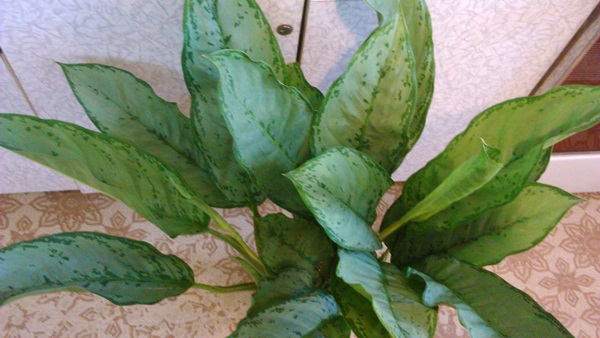 Aglaonema Friedman
Aglaonema Friedman
This variety has other names - Gabrielle or Cecilia. The height of the bush is 150 cm, and the leaf plates are very decorative. They are very large in the light field with dark green spots. The edges of the sheet are bent by a wave.
The variety is not whimsical and the flowering is no different from other varieties.
Pattaya beauty
 Aglaonema Pattaya beauty
Aglaonema Pattaya beauty
Thailand is considered the homeland of the variety, where it can be found in the wild. The variety is tall and has charming foliage. The foliage is green, along which the olive spots are located, along the edge of the leaf there is a dark green stripe bounding the leaf. The length of the leaf plate reaches 12 cm. Flowering does not differ from other varieties - a white ear with a blanket of the same color.
Whichever variety is chosen, it needs appropriate care.
Description of the plant
Today, about 50 species and several hundred hybrids of Aglaonema are known. Aglaonema Maria (from the Greek aglos - bright, nema - thread), another name for which is the Emerald Beauty, given due to the bright emerald color of the leaves, gained the greatest popularity in home keeping.
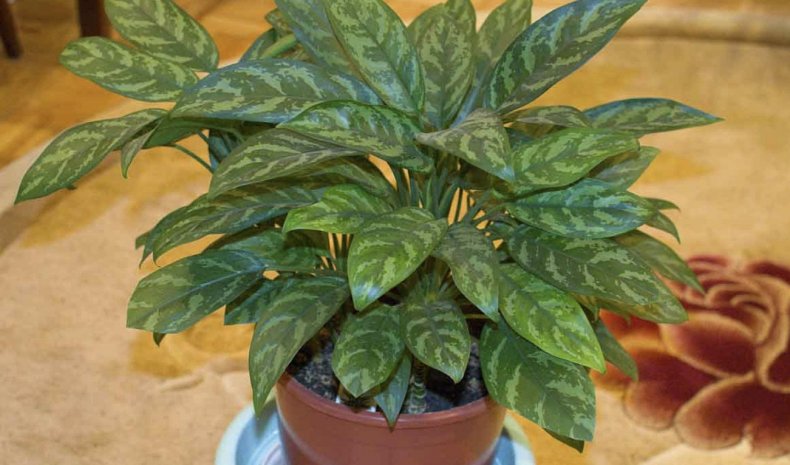
Maria is a compact bush, as it has relatively small leaves. The general background of the leaf plate is bright, with a glossy sheen and pronounced dark green stripes along the edges of the leaf. The stalk is wide at the base, as the flower grows, it will become denser, “stiff”. It blooms in summer, but not every year. The flower is yellow-green in color, pale in color. If pollination occurs, red berries with one seed ripen. Germination period is short, maximum - 8 months.
Important! Aglaonema can be dangerous to children and pets due to the caustic juice and poisonous berries. In addition to aglaonema Maria, other varieties are popular in home floriculture:
In addition to aglaonema Maria, other varieties are popular in home floriculture:
- Red;
- Modest;
- Silver (subspecies: Silver Bay, Silver Queen, silver-blue);
- Changeable;
- Maria Christina;
- Maria Anna.
The best aglaonema varieties with photos and names
Aglaonema King of Siam or King of Siam King of Siam

Aglaonema King of Siam King of Siam photo
Powerful petioles are rather tall, white in color, holding dense dark green leathery leaves with expressive white veins. The bush is compact, densely leafy.
Aglaonema Maria Aglaonema Commutatum Maria

Aglaonema Maria Aglaonema Commutatum Maria photo
The variety Maria fell in love with due to the very beautiful coloring of the leaves: on a dark green background, light spots-stripes pass in a symmetrical herringbone pattern in the direction of the veins. The leaves are elongated, the bush is compact.
Aglaonema Silver Queen Silver Queen
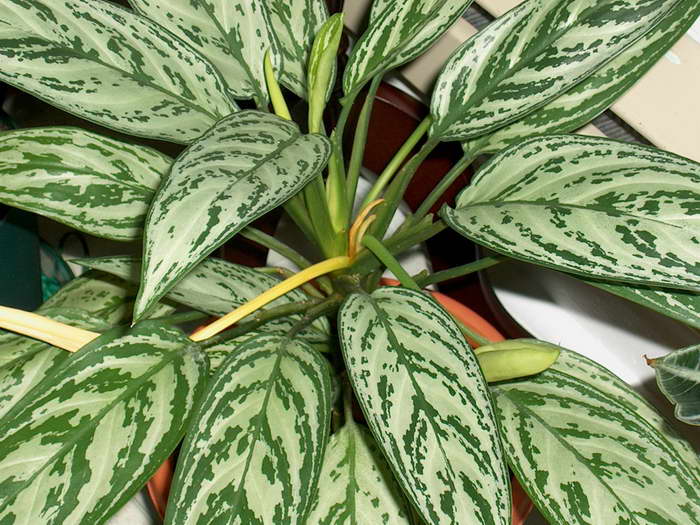
Aglaonema Silver Queen Silver Queen photo
The stunning color of the Silver Queen variety, combined with the beautiful shape of the leaf, made the Silver Queen a real master among all Aglaonems.
Aglaonema Silver Bay
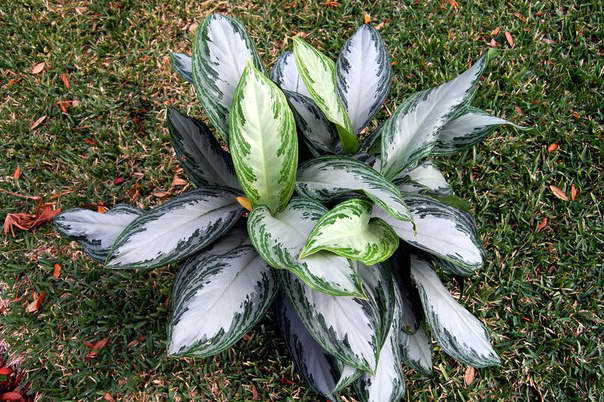
Aglaonema Silver Bay Aglaonema Silver Bay photo
Almost white, with a silvery shade, with dark green outlining strokes along the edge, the leaves of this plant look mesmerizing. You just can't take your eyes off the Silver Bay variety.
Aglaonema red Crete Aglaonema Crete

Aglaonema Crete Aglaonema Crete photo
The Crete variety is notable for a rare shade of crimson-red outlining stripes along the edge of the leaf and rare veins. Leaves are elongated, pointed, slightly sinuous, bent inward in the center.
Aglaonema Stripes Aglaonema Stripes
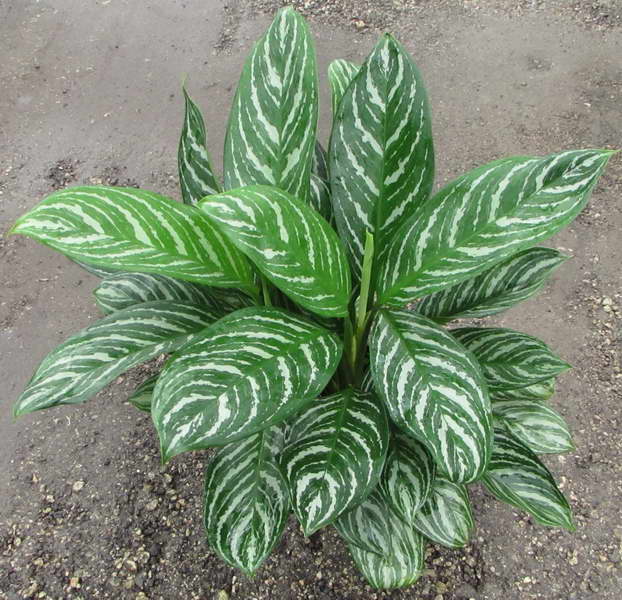
Aglaonema Stripes Aglaonema Stripes photo
A playful zebra-like striped pattern will bring a fresh touch to any interior. The Strips variety effectively fits into the conditions of an apartment and office.
Aglaonema Maria Christina Aglaonema Commutatum Maria Christina
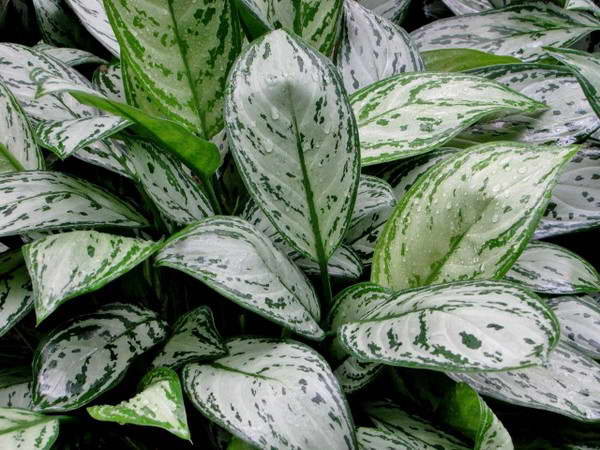
Aglaonema Maria Christina Aglaonema Commutatum Maria Christina photo
An amazing bluish-silver shade with small dark green spots-stripes along the veins and along the edge of the leaf makes an indelible impression. The variety Maria Christina is effectively combined with dark green and red deciduous plants.
Aglaonema Pink Aglaonema Pink
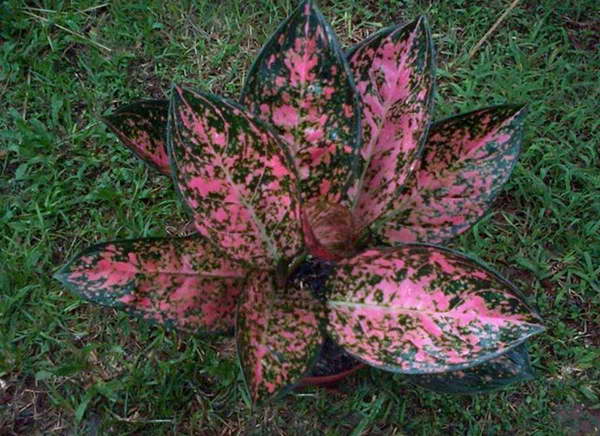
Aglaonema Pink Aglaonema Pink Ruby photo
Pink varieties (pink) are very interesting for their unusual color with small or large dark green spots. The drawings are very diverse, which opens up a wide scope for imagination in creating compositions that decorate the interior.
Aglaonema Diamond Bay
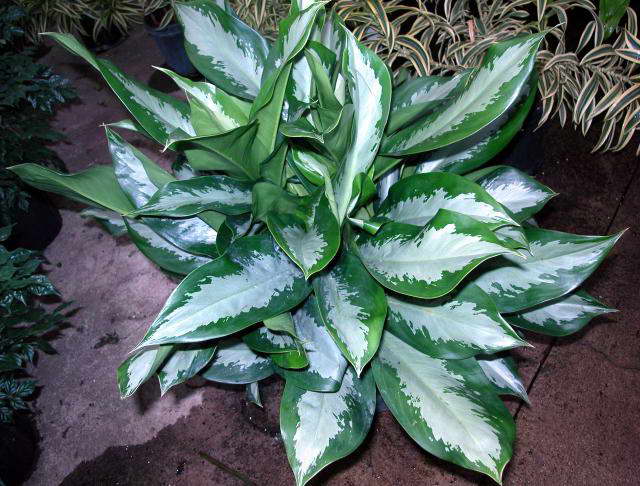
Aglaonema Diamond Bay photo
The variety Diamond Bay with long pointed leaves, slightly curled, has a compact, densely leafy crown. The colors are also original: dark green along the edges, leaves of a greenish-silvery shade in the center.
Aglaonema AnYaManee
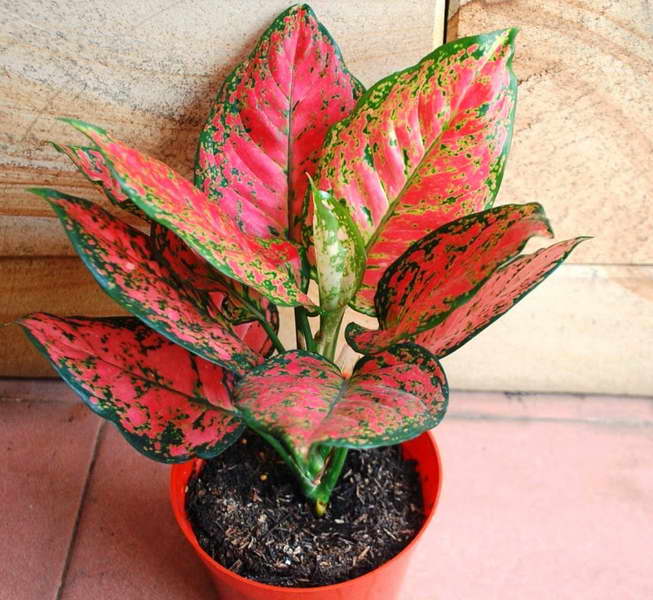
Aglaonema anyamanee photo
The pink AnYaManee is particularly popular for its colorful shades of pink and green with a quirky marble pattern. Leaves are leathery, dense, with a slight gloss.
Aglaonema Sab Mongol
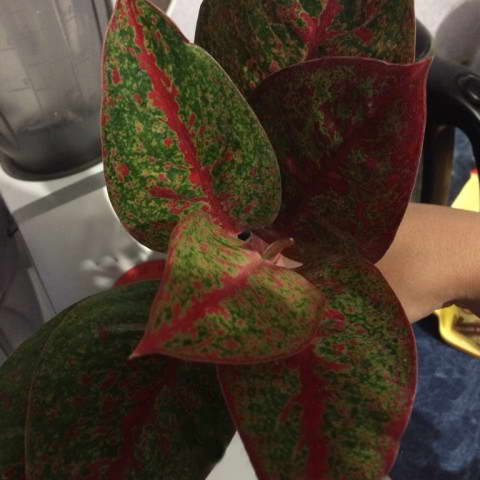
Aglaonema sab mongol photo
Luxurious leaves with a velvet pattern of rich burgundy and green shades are simply mesmerizing to the eye. The Sab Mongol variety will decorate any interior, introducing elements of luxury.
Aglaonema Green Lady
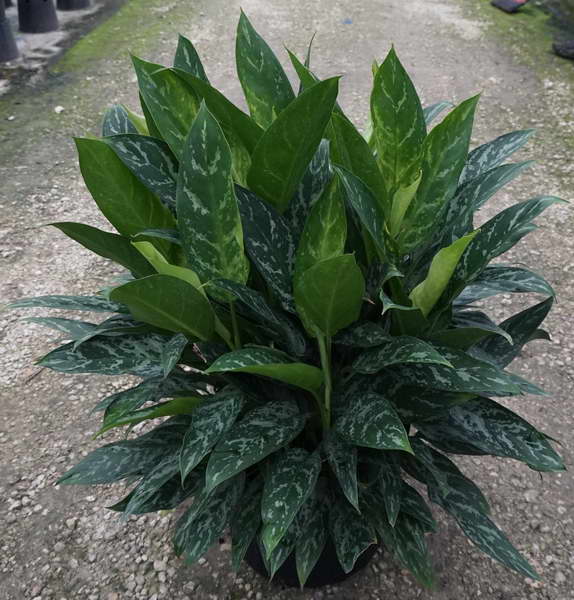
Aglaonema Green Lady Aglaonema Green Lady photo
Green Lady Aglaonema Green Lady is very effective due to the beautiful shape of the leaves with pointed tips and variegated color, mixing rich green and light green with a silvery shade.
Aglaonema Cutlass Aglaonema Cutlass
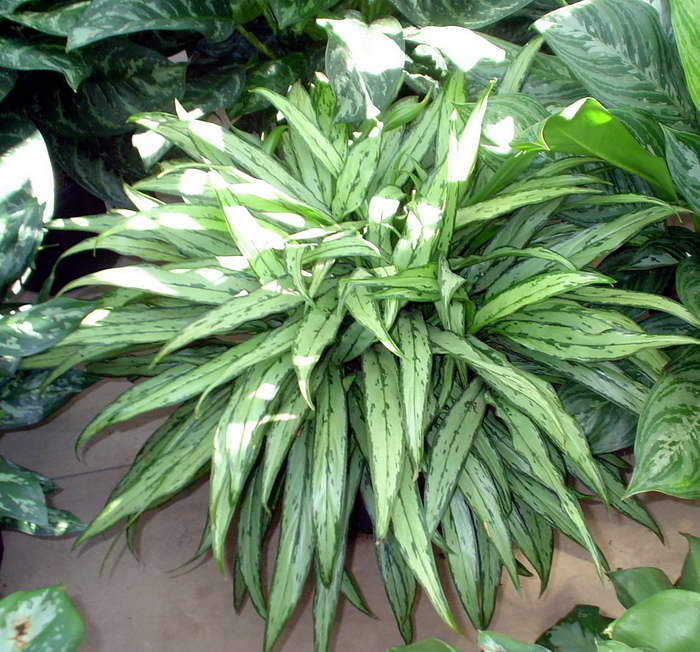
Aglaonema Cutlass Aglaonema Cutlass photo
The peculiarity of the Cutlass variety Aglaonema Cutlass is its long, narrow leaves, collected in a dense rosette, reminiscent of the top of a palm tree. Delicate light green, almost silvery color, shaded by dark green veins and bumps along the edge of the leaves.
Aglaonema Palace Thailand aglaonema palace thailand
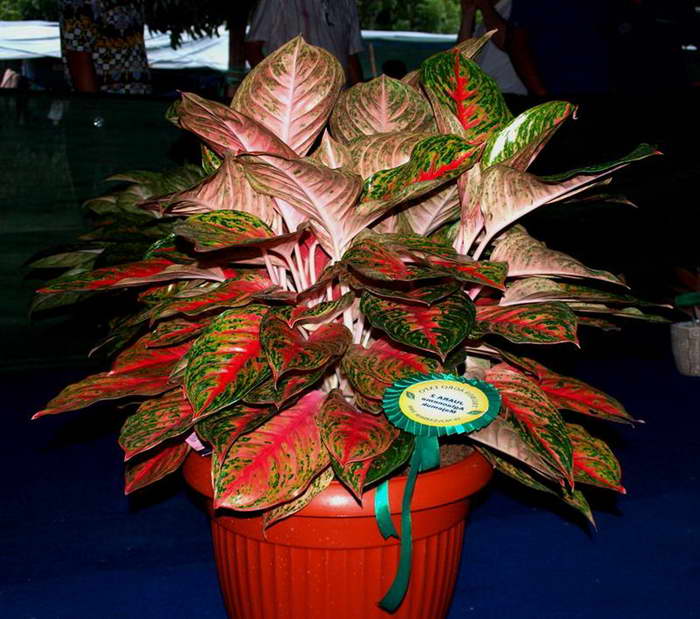
Aglaonema Palace Thailand aglaonema palace thailand photo
The varieties of the Palace series with various shades of color are no less attractive. Ribbed leaves with expressive veins look very impressive.
Diseases and pests
Aglaonema Maria can be exposed to harmful insects (aphids, thrips, spider mites, worms). A signal of this will be spots on the sheet plates, yellowing. If the number of pests is insignificant, treatment with a solution of laundry soap and a plentiful shower will help. If the process has gone far, the plants should be treated with fungicides (karbofos), while strictly observing the dosage and rules for using the product.
With too much watering, a home flower becomes ill with fungal diseases - gray rot. The affected leaves are removed. Improper watering can kill the plant.
Did you know? Aglaonema leaves release phytoncides into the environment, which are harmful to pathogenic microbes. The plant also neutralizes formaldehyde in the air.
A spectacular, bright green plant is undoubtedly a decoration apartment or office... Subject to the simple rules of care and the correct temperature regime, Aglaonema Maria will delight you with decorativeness for a long time and bring benefits - to purify the air.
Stunted aglaonema
Low-growing varieties with a height of 25 cm and creeping or drooping stems are represented by the following species.
Aglaonema ribbed
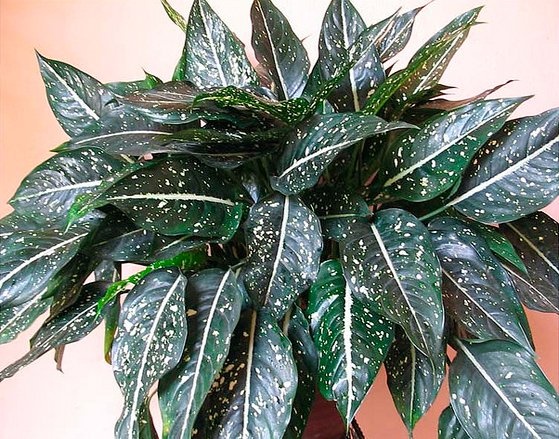
- soncolor has green leaves on both sides;
- virescens has only a green central vein, the rest of the leaf is white on both sides;
- immaculatum is distinguished by white color of the leaves on the front side;
- costatum has leaves with a white central vein and small spots.
Aglaonema short-covering

This variety is also distinguished by underground or creeping stems, which release only pointed, highly elongated, oval green leaves with a central white vein to the surface. To obtain a decorative look, several seedlings should be planted in one pot, since the growth of this specimen is slow, and there are not so many leaves.
Aglaonema rounded
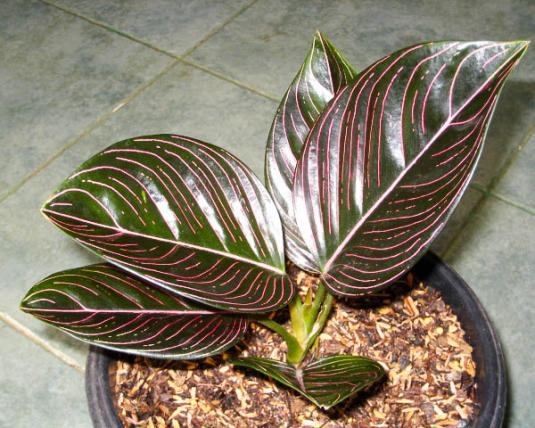
This variety is the most decorative thanks to the heart-shaped black and red leaves, on which the pattern of pink stripes stands out in contrast.
Home care for aglaonema
Lighting and air temperature
In its natural environment, aglaonema grows in the lower tier of tropical rainforests, where a small amount of light penetrates, i.e. the plant is shade-tolerant. Indoor growing conditions must also correspond to this. Create partial shade, avoid direct sunlight, harmful burns. Variegated forms require bright diffused lighting to preserve the decorative pattern.
The optimum air temperature is between 20-25 ° C. Sudden temperature changes and drafts must be avoided. By winter, gradually lower the air temperature to 16-18 ° C.
Watering and spraying
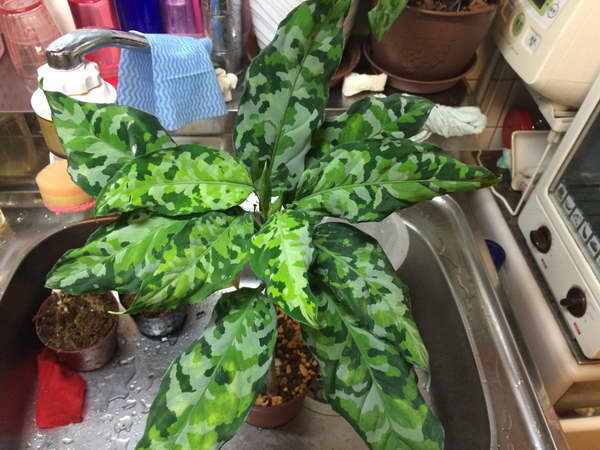
Aglaonema loves water treatments as part of her care
Water abundantly in spring and summer, only the top layer of the soil should dry out. In autumn and winter, moderate watering is required, you will have to water it about every 2 days, focusing also on the drying of the top layer of the soil.For irrigation, use soft, settled water at room temperature.
It is necessary to maintain high air humidity. Spray the plant daily. You can place the aglaonema on a pallet with damp peat, expanded clay or pebbles, but the bottom of the pot should not come into contact with water. Spray sparingly as temperatures drop in fall and winter. Bathe the plant occasionally in a warm shower. Water procedures not only increase humidity, but also provide plant respiration and protect it from pests.
When the air is dry, the leaves unfold poorly, deform, their edges and tops dry out.
Top dressing
From March to August (active growing season), you need to feed the plant every 2 weeks. Alternate organic and mineral supplements of normal concentration. In autumn and winter, the plant has a dormant period - no feeding is needed.
Planting soil
For successful growth, the plant needs a light substrate that is well permeable to air and moisture. The following soil compositions are suitable: 3 parts of leaf land, 1 part each of sand, peat, 0.5 part each of humus and charcoal, or 2 parts of leaf land, 1 part each of sand and peat with the addition of a small amount of charcoal. Will grow well in hydroponics. Be sure to lay drainage at the bottom of the container.
Transfer
Young plants are transplanted annually; adult specimens require transplantation as they grow (approximately every 3-5 years). The root system is shallow, so the pot is not needed large. In a too large container, the roots will braid with an earthen ball for a long time, which will delay flowering and fruiting.
Aglaonema ribbed
It grows in the Malaysian tropics, undersized type. The trunk can branch, it has ovoid leaves with a pointed end, 20 cm long, no more than 10 cm wide.
The color is dark, on the central vein there is a light stripe. The flowering of aglaonema is expressed in the formation of a white cob, covered with a large greenish blanket.
Many hybrid forms were obtained from the maternal individual, derived from closely related crossbreeding with other subspecies. Most of the specimens do not have their own name, they are presented under the name "Thai aglaonema" or "ribbed hybrid".
Representatives include First Diamond - erect, with green foliage. The young have practically white plates with darkish spots.
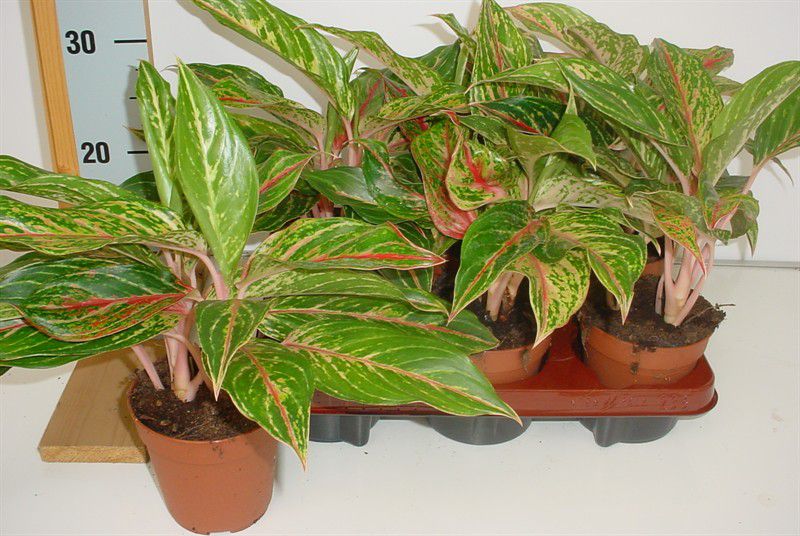
Aglaonema Butterfly
Planting and leaving

The pot for planting must be chosen not high, but wide enough. Aglaonema is a slow-growing species, so it is often unnecessary to replant it. This should be done at the moment when the old leaves dry up and new ones actively appear. Transplant very carefully, as damage to the roots or trunk can lead to the early death of the plant.
The ideal place for the plant is the eastern window, where direct sunlight does not fall on it (this recommendation is general, since there are certain varieties that like direct light).
Suitable temperatures range from 18 ° C to 25 ° C. The plant must avoid sudden temperature changes and hypothermia (with the exception of resistant varieties that can tolerate any conditions), the minimum allowable temperature is 16 ° C.
Watering and humidity:
- Water for irrigation should be soft.
- Watering should be 2-3 times a week (except for those varieties that like abundant moisture), after the topsoil dries.
- In winter, watering should be done a few days after the topsoil dries.
- Air humidity is very important, therefore, aglaonema must be periodically sprayed from a spray bottle.
- This plant needs to be washed under a cool shower.
The soil should be light to allow moisture and air to pass through. To prepare a suitable substrate yourself, you need to mix leafy soil with sand and peat in a 3: 1: 1 ratio. You can add some charcoal to them.
It is worth feeding the plant with mineral fertilizers containing trace elements. Fertilize after watering, in shade conditions, as due to fertilizers combined with light, burns may appear on the leaves.
Advice! If the plants are not on the windowsill, then in winter special lamps should be used for additional lighting.
Watering in winter is done with warm, settled water, abundantly. Drain excess water. If the plant is on the windowsill, then it may strongly dislike the dried out warm air. To avoid this, it is necessary to put pallets with wet expanded clay. The plant should be bathed less frequently in winter than in summer.
When the trunk of the aglaonema is bare, it should be cut off. The upper part is removed, the cut is treated with charcoal and dried well. The cut part is placed in a glass of water to form roots. The water must be boiled and disinfected. The stalk can be planted in the soil right away, but then you need to create a kind of greenhouse for it.


